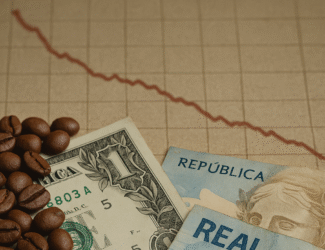
Coffee Market Report: May 2024 Global Coffee Prices Witness Volatility Amid Dynamic Market Forces
The coffee market in May 2024 experienced notable fluctuations influenced by a confluence of economic, environmental, and logistical factors. The latest report from DRWakefield, a renowned independent coffee trader, provides an in-depth analysis of these developments, offering insights for traders, producers, and coffee enthusiasts.
Founded in London in 1970 by Derrick Wakefield, DRWakefield has built a reputation for supplying both specialist and regular grade coffees to a diverse range of clients, from small private roasters to large multinational companies. The company continues to operate under the ownership of Simon Wakefield, maintaining its philosophy of building strong relationships and understanding customer needs. With offices in London and Vilnius, and European warehouses, DRWakefield remains committed to providing the right coffee for its global clientele.
Market Movements and Speculation
May saw mixed sentiment in the coffee market, characterized by alternating bullish and bearish trends. Early in the month, a bullish outlook prevailed as traders anticipated potential supply shortages due to various global factors. However, this optimism was tempered by bearish signals as the month progressed:
- Bullish Sentiments: Initial market enthusiasm was driven by concerns over reduced supply from major coffee-producing regions, exacerbated by environmental challenges and logistical bottlenecks. This led to a surge in coffee futures prices.
- Bearish Trends: As pending grading stocks began to pile up, market sentiment shifted. The increase in pending grading stocks, which are not yet certified, suggested a potential influx of supply, driving prices down and indicating a bearish market outlook.
Certified Stocks and Supply Dynamics
Certified stocks of coffee, which are essential for maintaining market stability, saw significant fluctuations:
- Decrease in Certified Stocks: There was a notable reduction in certified stocks, reflecting high demand and substantial drawdowns from global warehouses. This decrease often signals market confidence in current supply levels but raises concerns about future availability.
- Supply Concerns: The decrease in certified stocks coupled with high spot demand led to backwardation in the market, where the front month’s prices were higher than those of future months. This condition highlights immediate supply concerns and market tightness.
Impact of Biennial Production Cycles
Biennial production cycles in key coffee-growing regions significantly influenced market stability:
- Higher Yields and Market Adjustment: Coffee trees typically produce higher yields in alternating years. The higher yields from the previous year led to expectations of lower production this year, contributing to price volatility as traders adjusted their forecasts accordingly.
Technical Indicators and Market Sentiment
Several technical indicators provided insights into market trends and trader behavior:
- Relative Strength Index (RSI): The RSI indicated an overbought market early in the month, suggesting that prices had risen too quickly. This was later confirmed as prices adjusted downward, indicating a market correction.
- Commitment of Traders (COT) Reports: The COT reports revealed mixed sentiments among market participants. Speculators, often referred to as “the funds,” increased their short positions, anticipating a price drop, while commercial traders hedged against potential risks by maintaining their positions.
Economic Factors and Global Impacts
Economic conditions played a crucial role in shaping the coffee market dynamics:
- Consumer Price Index (CPI): Rising inflation, as reflected in the CPI, drove up costs across the coffee supply chain. This inflationary pressure affected everything from production costs to shipping fees, influencing overall coffee prices.
- Hawkish Monetary Policies: Major central banks, aiming to curb inflation, adopted hawkish monetary policies, increasing interest rates. These policies impacted currency values, particularly the US dollar (referred to as the “greenback”), which in turn affected coffee prices internationally.
Logistics and Shipping Challenges
Global logistics and shipping issues continued to complicate the coffee trade:
- Container Shortages and Port Congestion: Ongoing shortages of shipping containers and congestion at major ports created delays and increased costs. These logistical challenges disrupted the supply chain, contributing to market volatility.
- Impact on Coffee Trade: Delays in shipping and increased transportation costs affected the timely delivery of coffee, influencing both spot prices and futures contracts.
Future Outlook
Looking ahead, the coffee market is expected to remain dynamic, with various factors influencing price movements and market stability:
- Monitoring Certified Stocks: The level of certified stocks will be a critical indicator of market health. Traders and stakeholders need to watch for changes in these stocks to gauge supply conditions.
- Production and Environmental Factors: Biennial production cycles and environmental conditions in key coffee-growing regions will continue to play a significant role in shaping market dynamics.
- Economic and Policy Developments: Global economic conditions and monetary policies will influence market sentiment and pricing strategies. Traders should remain vigilant about changes in interest rates and inflation trends.
In conclusion, May 2024 was a month of significant volatility in the coffee market, driven by a complex interplay of supply and demand dynamics, economic factors, and logistical challenges. Traders and stakeholders will need to navigate these complexities carefully, balancing short-term market movements with long-term considerations to make informed decisions in the ever-evolving coffee market.
- By : Qahwa World
- On :
Latest Posts
- Komerz Inks Exclusive Deal to Distribute Beanies and Coffeeway Brands in UK Coffee Market
- Barista Terminology | Episode 5: Milk Texturing & Latte Art
- Arabica Coffee Prices Drop as Brazil Crop Conditions Improve
- Black Rifle Coffee Company Sets August Dates for Q2 2025 Earnings Release and Investor Call
- RAW Coffee Company Offers Free Espresso Machine Health Checks This Summer



